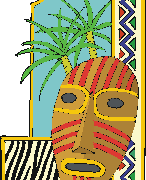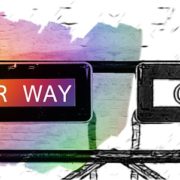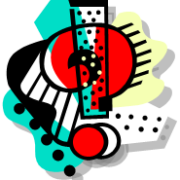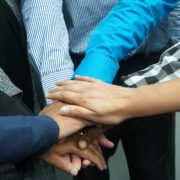The Masks We Wear
By Ellen Borowka
Masks have long been a part of daily life. From the past when tribal dancers wore them to worship their gods, to the present where children wear them for special holidays like Halloween. Our ancestors used masks for a variety of reasons. Some were worn to portray spirits, gods or animals; and others were used to protect and guard against misfortune and disease. There were masks to maintain contact with the dead through burial rituals or in ancestor worship; to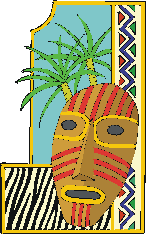 represent characters in theater; and to celebrate the change of seasons and festivals.
represent characters in theater; and to celebrate the change of seasons and festivals.
Masks in Everyday Life
We use masks in everyday life too. Usually not made of wood, clay or stone as in primitive times, but one that seems invisible though it too conceals our true nature. This mask is the image or facade we present to others. It is our false self that was developed in response to an unsafe and demanding environment. We have different reasons for using this type of mask. We may want to protect ourselves from getting hurt or rejected by others. We may want to become what others want us to be, in order to be accepted by them. Perhaps we feel no one would like or love who we truly are, so we hide our true self. Or we might not like ourselves so we try to pretend to be like someone else.
Yet, I think the core issue is not feeling loved by others and ourselves. This seems to fuel our insecurities and we may find ourselves willing to do anything to be loved by others. Even denying our true self – who we are – our beliefs, our values, our desires, our needs. If we don’t love ourselves, then we depend on others to provide that love and make us feel worthwhile. Yet, they may look to us to provide the same thing! That makes for a very unstable foundation for our relationships as well as for our psyche.
How Do We Cope?
Coping mechanisms, like pleasing others, are based in these insecurities. We seem to develop our mask as a way to handle our fear of rejection and other painful feelings. Those who wear masks on Halloween are in disguise – pretending to be another person or creature. If we are conscious of our masks then we know we are not what we pretend to be. Many are not aware of the mask they present to others. Like the tribal dancer, we can in some ways become the mask we present. The facade can take over where we may feel we have little control over our lives. Whereas our ancestors may have believed that one’s religious or magical powers are released by changing identity and becoming another being, we actually lose our power when we allow our mask or false self to take over our lives. If we can’t be true to ourselves then we deny our expression, our soul, and we deny the light we bring to this world. I believe that each of us is here to not only discover and accept our unique qualities, but also to share them with others. That is the healing process when we touch heart to heart.
What’s Our Mask?
So, what kind of masks do we wear? I would say that our mask changes to meet the demands of the environment. In other words, our mask or false self depends on our external world whereas our real self relies on our internal world. Our mask reacts to the demands of our environment and our true self responds to our needs and desires. There are many different masks or coping mechanisms we take on. We may push ourselves to be perfect in how we look and/or how we act. We may deny our feelings of sadness or anger or fear, because we may have learned these feelings are “bad” or unimportant. We may feel we must always be right or good or knowledgeable. We may feel we have to care for everyone else to be loved and needed. Or perhaps we think we exist only to make others happy. These are just some of the masks we wear.
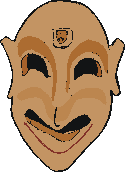 What kind of mask do you wear? What are some expectations you put on yourself or false concepts you have of yourself? Do you think you “have to” or “should” or “must” do or say or be a certain way to be loved and accepted by others? If so, that might be part of your mask. A good exercise to learn more about your mask is to create a mask that represents the qualities of your false self. You can draw with markers or crayons and/or use parts of magazine pictures and words to create a life-size mask. Clay or paper mache with acrylic paints is also a good medium, and symbols are helpful to give your mask depth. Or you could write about it.
What kind of mask do you wear? What are some expectations you put on yourself or false concepts you have of yourself? Do you think you “have to” or “should” or “must” do or say or be a certain way to be loved and accepted by others? If so, that might be part of your mask. A good exercise to learn more about your mask is to create a mask that represents the qualities of your false self. You can draw with markers or crayons and/or use parts of magazine pictures and words to create a life-size mask. Clay or paper mache with acrylic paints is also a good medium, and symbols are helpful to give your mask depth. Or you could write about it.
One might think it is necessary to get rid of the mask to allow the true self to be seen. Yet, actually we need both to live in this world and as our world becomes safer then we may need our mask less and less. George Washington once advised, “Be courteous to all, but intimate with few, and let those few be well tried before you give them your confidence.” So, we need our mask to protect our inner self. What is also needed is to have a balance between the two – allowing our inner light to shine out to others, while protecting it from those that cannot appreciate it. Our masks are not bad, but it just comes down to choice. The real self has choices of how to be, but the false self depends on others for how it should be.
Finding Balance
How do you find a balance? Some ways are to explore your inner world, and learn more about your true and false self. Begin to distinguish between the two, and discover all you can about yourself – not only your good qualities, but also your “bad” qualities or what Jung would call your shadow. The shadow contains our dark side and it’s important to explore the darkness and find healthy ways to express it. Work to appreciate and accept your qualities, your style, your strengths and your weaknesses. Support your realness to come to the surface while still acknowledging the need for your protective mask.
Being Real
Allowing your inner self to come forth is scary as it risks rejection, so you might want to take small steps in your risktaking to feel safer. Some may have so much pain and anger from past rejections or betrayals that assistance may be needed. When the past needs to be healed first, I suggest turning to a counselor or clergy for help. Norman Cousins once said, “The great tragedy of life is not death, but what dies within us while we live.” Don’t let your mask suffocate your inner light, but rather use it to create safety and security so your light burns brightly to the world.
Permission is needed from Lighthouse Consulting Services, LLC to reproduce any portion provided in this article. © 2014 This information contained in this article is not meant to be a substitute for professional counseling.
Ellen Borowka, MA, Senior Analyst of Lighthouse Consulting Services, LLC and her organization constantly remain focused on their mission statement – “To bring effective insight to your organization”. They do this through the use of in-depth work style assessments to raise the hiring bar so companies select the right people to reduce hiring and management errors. They also have a full service consulting division that provides domestic and international interpersonal coaching, executive onboarding, leadership training, global options for expanding your business, sales and customer service training, operational productivity improvement, 360s and employee surveys as well as a variety of workshops. Ellen has over 15 years of data analysis and business consulting experience and is the co-author of the books, “Cracking the Personality Code” and “Cracking the Business Code”. To order the books, please visit www.lighthouseconsulting.com.
If you would like additional information on this topic or others, please contact your Human Resources department or Lighthouse Consulting Services LLC, 3130 Wilshire Blvd., Suite 550, Santa Monica, CA 90403, (310) 453-6556, dana@lighthouseconsulting.com & our website: www.lighthouseconsulting.com.
Lighthouse Consulting Services, LLC provides a variety of services, including in-depth work style assessments for new hires & staff development, team building, interpersonal & communication training, career guidance & transition, conflict management, 360s, workshops, and executive & employee coaching. Other areas of expertise: Executive on boarding for success, leadership training for the 21st century, exploring global options for expanding your business, sales and customer service training and operational productivity improvement.

